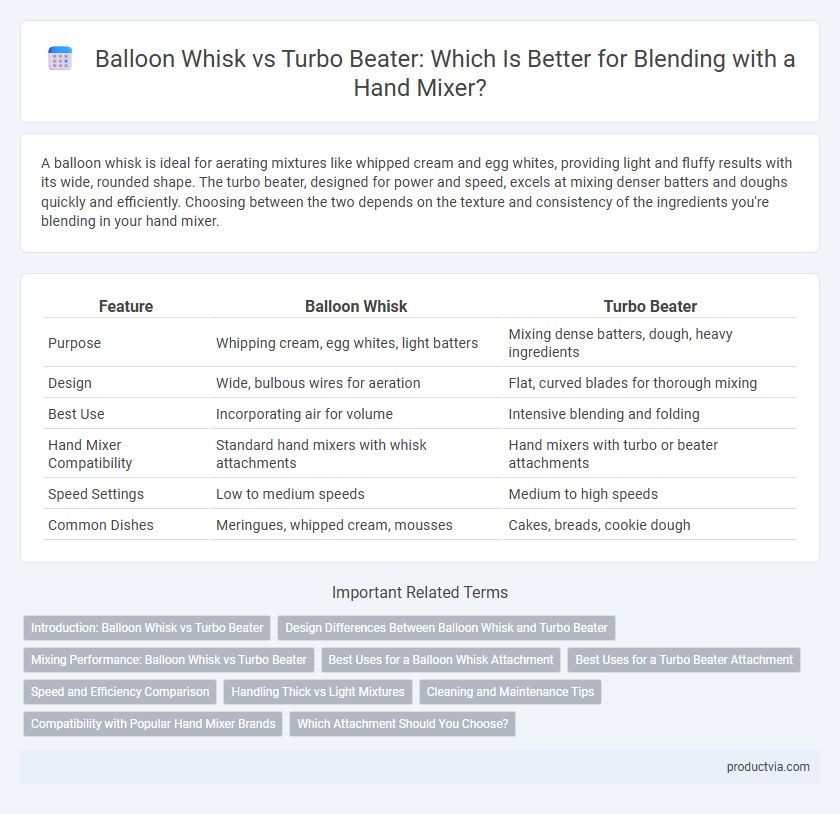A balloon whisk is ideal for aerating mixtures like whipped cream and egg whites, providing light and fluffy results with its wide, rounded shape. The turbo beater, designed for power and speed, excels at mixing denser batters and doughs quickly and efficiently. Choosing between the two depends on the texture and consistency of the ingredients you're blending in your hand mixer.
Table of Comparison
| Feature | Balloon Whisk | Turbo Beater |
|---|---|---|
| Purpose | Whipping cream, egg whites, light batters | Mixing dense batters, dough, heavy ingredients |
| Design | Wide, bulbous wires for aeration | Flat, curved blades for thorough mixing |
| Best Use | Incorporating air for volume | Intensive blending and folding |
| Hand Mixer Compatibility | Standard hand mixers with whisk attachments | Hand mixers with turbo or beater attachments |
| Speed Settings | Low to medium speeds | Medium to high speeds |
| Common Dishes | Meringues, whipped cream, mousses | Cakes, breads, cookie dough |
Introduction: Balloon Whisk vs Turbo Beater
The balloon whisk is designed with wide, flexible wires that incorporate more air into mixtures, making it ideal for whipping cream and egg whites to achieve light, fluffy textures. In contrast, the turbo beater features closely spaced, sturdy blades that provide intense mixing power, perfect for blending dense batters and doughs efficiently. Choosing between the balloon whisk and turbo beater depends on the specific hand mixer blending task, optimizing performance for either aeration or thorough mixing.
Design Differences Between Balloon Whisk and Turbo Beater
The balloon whisk features thin, widely spaced wires forming a rounded shape ideal for incorporating air into mixtures, making it perfect for whipping cream or egg whites. In contrast, the turbo beater possesses a flat, multi-pronged design with closely packed blades optimized for thorough blending and mixing of denser ingredients like cake batter or dough. These design differences directly impact blending efficiency and texture outcomes when using a hand mixer in various culinary applications.
Mixing Performance: Balloon Whisk vs Turbo Beater
The balloon whisk excels in incorporating air into mixtures, making it ideal for whipping cream and egg whites to achieve light, fluffy textures. The turbo beater offers faster blending speeds and enhanced power, delivering efficient mixing of thicker batters and doughs with smooth, consistent results. Choosing between the two depends on the desired texture and mixing speed for optimal hand mixer performance.
Best Uses for a Balloon Whisk Attachment
A balloon whisk attachment for a hand mixer excels at incorporating air into mixtures, making it ideal for whipping egg whites, cream, and light batters. Its balloon-shaped wires increase aeration, producing fluffy and airy textures perfect for meringues and whipped cream. Compared to a turbo beater, which is better suited for heavy doughs and dense mixtures, the balloon whisk delivers superior performance in creating light, volume-rich blends.
Best Uses for a Turbo Beater Attachment
The Turbo Beater attachment excels at blending dense batters and doughs, delivering powerful mixing for cake, cookie, and bread recipes. Its robust design ensures rapid incorporation of ingredients and is ideal for heavy mixtures that challenge standard balloon whisks. Compared to balloon whisks, the Turbo Beater minimizes mixing time and improves consistency in thick, heavy blends.
Speed and Efficiency Comparison
Balloon whisks excel in aerating mixtures quickly, making them ideal for whipping egg whites and cream at moderate speeds with high efficiency. Turbo beaters, designed with angled blades, achieve faster blending and mixing by increasing contact with ingredients, offering superior performance in speed for denser batters. Choosing between balloon whisks and turbo beaters depends on the specific hand mixer task, balancing aeration needs against rapid, thorough mixing efficiency.
Handling Thick vs Light Mixtures
Balloon whisks are ideal for incorporating air into light mixtures like egg whites and whipped cream, providing a smooth, fluffy texture with minimal effort. Turbo beaters excel at handling thick, dense mixtures such as cookie dough or batter, delivering powerful, consistent blending through their robust design. Choosing between the two depends on the hand mixer's intended use: balloon whisks for light, airy blends and turbo beaters for heavy, viscous ingredients.
Cleaning and Maintenance Tips
Balloon whisks feature thin, flexible wires that can trap batter, requiring careful cleaning with a brush to remove residue effectively. Turbo beaters have thicker blades with fewer crevices, making them easier to rinse quickly under running water without leftover buildup. Regular soaking in warm soapy water and avoiding abrasive sponges ensures longevity and maintains optimal hand mixer performance.
Compatibility with Popular Hand Mixer Brands
Balloon whisks are widely compatible with popular hand mixer brands such as KitchenAid, Cuisinart, and Hamilton Beach, offering versatility for whipping cream and egg whites with superior aeration. Turbo beaters, designed for intensive mixing tasks, fit select models from brands like Braun and Philips, providing powerful performance for dense batters and doughs. Choosing between balloon whisk and turbo beater attachments depends on your hand mixer's brand compatibility and desired blending efficiency.
Which Attachment Should You Choose?
Choosing between a balloon whisk and a turbo beater for hand mixer blending depends on the task: a balloon whisk is ideal for incorporating air into egg whites and cream, creating light and fluffy textures, while a turbo beater excels at efficiently mixing dense batters and dough. The balloon whisk's wide loops maximize aeration, making it perfect for meringues and whipped cream, whereas the turbo beater's spiral design tackles heavy mixtures with consistent speed. Selecting the right attachment ensures optimal blending performance and desired texture in your culinary preparations.
Balloon Whisk vs Turbo Beater for Hand Mixer Blending Infographic

 productvia.com
productvia.com